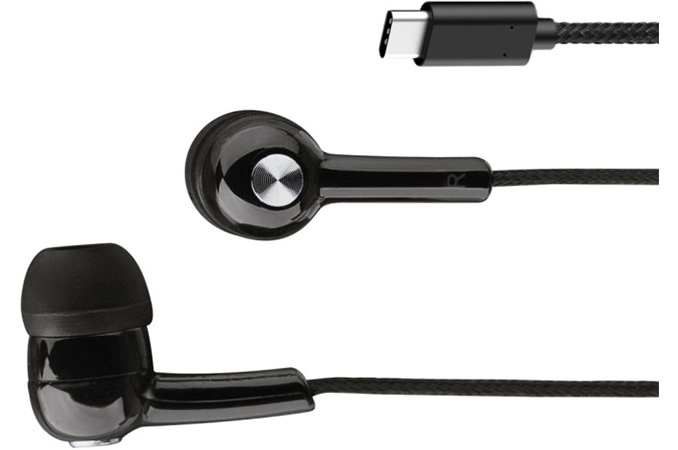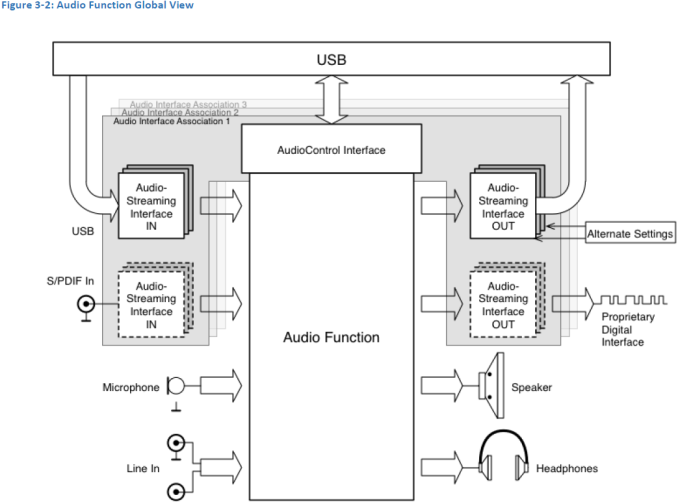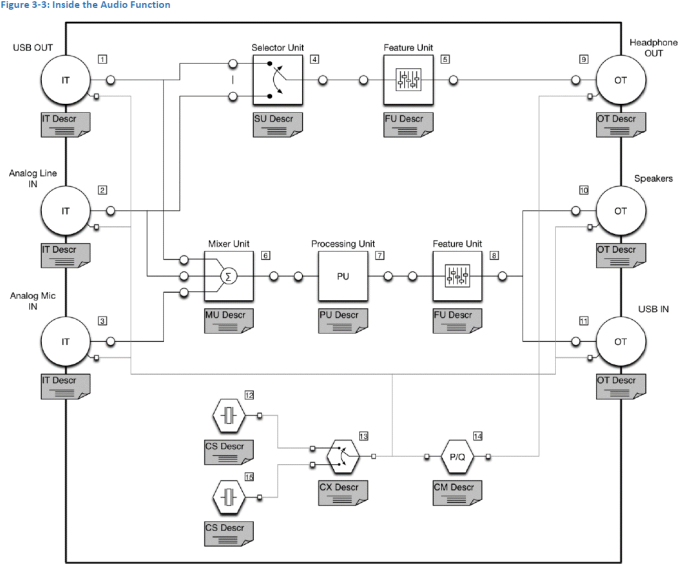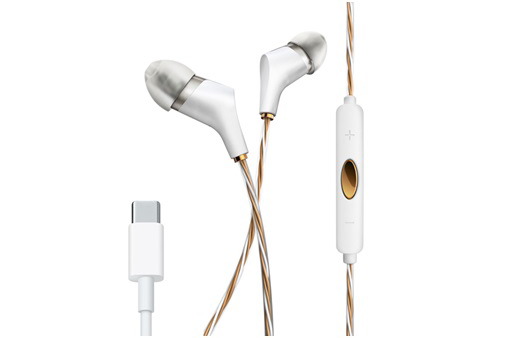USB-IF Publishes Audio over USB Type-C Specifications
by Anton Shilov on September 30, 2016 12:00 PM EST- Posted in
- Mobile
- USB-C
- USB-C Digital Audio

The USB Implementers Forum this week published the USB Audio Device Class 3.0 specification, which standardizes audio over USB Type-C interface. The new spec enables hardware makers to eliminate traditional 3.5mm mini-jacks from their devices and use USB-C ports to connect headsets and other audio equipment. Makers of peripherals can also build their audio solutions, which use USB-C instead of traditional analog connectors. Developers of the standard hope that elimination of mini-jacks will help to make devices slimmer, smarter and less power hungry.
The industry, led by Intel and some other companies, has been mulling about replacing the traditional 3.5mm mini-jack connector for some time now. The main motives for replacement were necessity to simplify internal architecture of devices by removing analog and some audio processing components from the inside (which leads to further miniaturization), minimize the number of external connectors, improve power management as well as to add smart features to headsets and other audio equipment. We discussed USB Type-C Audio Technology briefly earlier this year and mentioned that this is not the first time that the industry has tried to use USB instead of the good-old mini-jack. The important difference between contemporary initiative and attempts in the past is the fact that today the primary goal is to replace the 3.5mm jack in portable devices.
As reported, the USB Audio Device Class 3.0 specification supports both analog and digital audio. Analog audio is easy to implement and it does not impact data transfers and other functionality of USB-C cables since it uses the two secondary bus (SBU) pins. Some device makers may find the analog audio feature of the standard to be a relatively simple way to add certain smart capabilities to their headsets without major redesign of hosts. While analog USB-C audio will not help to shrink dimensions of portables, it could be particularly useful for non-mobile devices, where miniaturization is not crucial, but where port space is at a premium or where additional features either make sense (infotainment, sport equipment, etc.) or are fundamental (VR HMDs).
The USB ADC 3.0 defines minimum interoperability across analog and digital devices in order to avoid confusion of end-users because of incompatibility. In fact, all ADC 3.0-compliant hosts should support the so-called headset adapter devices, which allow to connect analog headsets to USB-C. However, digital audio is one of the primary reasons why companies like Intel wanted to develop the USB-C audio tech in the first place, hence, expect them to promote it.
According to the USB ADC 3.0 standard, digital USB-C headphones will feature special multi-function processing units (MPUs), which will, to a large degree, define the feature set and quality of headsets. The MPUs will handle host and sink synchronization (this is a key challenge for digital USB audio), digital-to-analog conversion, low-latency active noise cancellation, acoustic echo canceling, equalization, microphone automatic gain control, volume control and others. Such chips will also contain programmable amplifiers and pre-amplifiers, which are currently located inside devices. Besides, USB ADC 3.0-compatible MPUs will also support USB Audio Type-III and Type-IV formats (the latest compressed formats), but will retain compatibility with formats supported by ADC 1.0 and 2.0. Finally, among the mandated things set to be supported by USB-C Audio devices are new Power Domains (allows devices to put certain domains in sleep mode when not in use) as well as BADD (basic audio device definition) 3.0 features for saving power and simplified discovery and management of various audio equipment (each type of devices has its own BADD profile).
Over the past few months, Conexant has introduced three USB-C Audio MPUs (1, 2) for headsets, docking stations and other equipment. Assuming that these chips are compliant with the USB ADC 3.0 specs from a hardware standpoint, and the software is ready, actual devices featuring USB-C Audio could arrive in the coming months. Pricing of the first USB ADC 3.0-compliant MPUs is unknown, but in general MPU ICs do not cost too much. Moreover, as developers adopt smaller process technologies and a larger number of such chips hit the market, their prices are going to decline. In the end, it will be interesting to see where digital headphone prices end up. The MPUs will definitely add to the total bill of materials for a set of headphones, but at the same time they add new functionality as well, so the big question is how manufacturers then factor all of that into device pricing.
A number of companies, including Apple and LeEco, have already introduced smartphones that do not use traditional mini-jacks, and Google added support for USB DAC devices to Android over a year ago. The finalization of the USB ADC 3.0 spec, introduction of USB-C audio ICs, as well as design decisions of smartphone makers demonstrate that the industry is trying to eliminate 3.5mm jacks from mobile devices. The big question is whether the rest of the industry plans to do the same. It is true that portables are primary devices for music listening for many people. However, there are tens of applications which still rely on analog connectors, and hundreds of millions of people who use them either to consume or create content. To eradicate 3.5mm jacks completely, USB-C Audio promoters will have to work with thousands of vendors and this takes time. Consequently, it is too early to say that this is the end for the good-old mini-jack.
Images by Conexant, USB IF.
Source: USB IF













93 Comments
View All Comments
sprockkets - Saturday, October 1, 2016 - link
Says the apple moderator from appleinsider.Face it, dropping a standard plug that's worked for decades with something proprietary is NEVER an improvement.
CrimsonKnight - Monday, October 3, 2016 - link
Why are you mentioning Apple at all? The only time the article mentions Apple is to say that they have released a phone with no 3.5mm jack. The spec detailed in the article is from the USB-IF, a nonprofit on whose board sits not one person from Apple.Also, the USB Type C is not proprietary, it's a standard. Are you confusing this with Apple's lightning port?
Finally, technology moves forward. The 3.5mm jack has had its run, deal with it.
Impulses - Saturday, October 1, 2016 - link
I don't necessarily blame Apple, but I do think this is utterly pointless on a ton of devices where internal components will remain exactly the same...Yes digital audio out COULD be better (specially if you're hardcore and wanna use your own external amp etc) and yes a digital interface COULD lead to interesting smart headphones, but none of that SHOULD come at the cost of compatibility and the ubiquitous 3.5mm jack.
Making slimmer devices might be a valid excuse in some cases, but in a lot of cases it's just an easy way to milk people on accessories or pure trend chasing.
Android and iOS already featured digital audio out for a long time and neither was setting the market ablaze with high end headphones with built in DACs and DSP (tho there were some, Audeze Sine etc). Similarly, smart wearables remain a bit of a novelty (I own/wear a Moto 360 btw).
JeffFlanagan - Monday, October 3, 2016 - link
Of course it's been a long time coming, but for the last few years, geeks have loved to whine whenever anything changes, and have been falling for reactionary politics. Too many people cannot handle change.brucethemoose - Friday, October 7, 2016 - link
Uh huh.Did you say that about video interfaces a few years back, right? Well, I've got some bad news for you...
happyhappythomas - Tuesday, April 9, 2019 - link
I agree people are willing to use Bluetooth headphones, but get all het up about the lack of a headphone jack on their phones. By making USB-C headphones it gives you the opportunity to have better audio due to a better DAC built into the headphones. Heck, that's whats used in Bluetooth headphones anyway.Wardrop - Saturday, October 1, 2016 - link
Phones with two USB ports are inevitable I think. I wouldn't fret too much. Computers use to only have one or two USB ports when they were first introduced. Now you'd be hard pressed to find even a mini PC with less than 6 ports. Apple doesn't count as they have a history of reducing everything to one; single button mouse, single port iPhone for audio, data and power, Macbook with single USB port. Apple's way doesn't make any sense. It's idealist rather than realist.Flunk - Sunday, October 2, 2016 - link
That would defeat the purpose, you've still got two jacks then.__Miguel_ - Monday, October 3, 2016 - link
IMO, that will just result in consumer confusion.Because either A) only one of the ports is USB-C Audio enabled, and the consumer will either have to remember which one it is every time (and we all know how much consumer love to do that), thinking it's stupid to switch a port for no apparent reason, and making it more complicated for them to understand how to work the device, not to mention the throng of returns derived from "the USB-C Audio thingy" not working, because of course they'll end up plugging it in the wrong port, and it will not work as advertised; or B) both of the ports are USB-C Audio enabled, and the consumer will still go "so, which one is the Audio port? And where do I plug my 3.5mm headphones again?". Not to mention 2 USB-C Audio enabled ports are more expensive than just one, making the phone cost more...
So, yeah, two USB-C ports would be nice, but I'm just not seeing it being the case.
happyhappythomas - Tuesday, April 9, 2019 - link
I disagree with you on the Macbook argument. I would say that now on the toutchbar MacBooks you actually have more usable ports than the older Retina ones. On the retina MacBooks, you only got 2 USB A ports which are what most people would have used most. I don't think that the majority of users ever used the Thunderbolt ports on them.